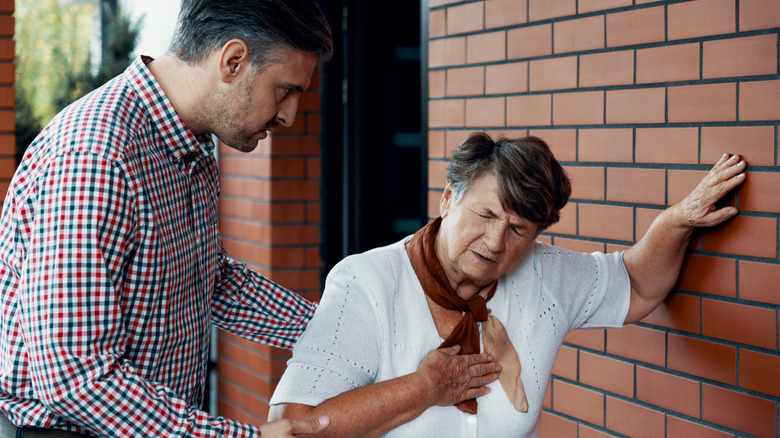Richard Pryor's Cause Of Death Explained
Comedian Richard Pryor died of a heart attack on December 10, 2005, at the age of 65 (per Biography). The "Stir Crazy" star's first heart attack occurred in 1978, but that did not slow down his career. According to Biography, many critics believe Pryor delivered his best work one year later with the film "Richard Pryor: Live in Concert." Pryor later suffered from what was called a "minor" heart attack while vacationing in Australia in 1990, per the Los Angeles Times. The actor was also diagnosed with multiple sclerosis in 1986, a disease that affects the nervous system. By the 1990s, he was restricted to a wheelchair, but that did not stop him from performing (via Biography).
Heart attacks are a form of heart disease, which is the leading cause of death in the U.S., according to the Centers for Disease Control and Prevention (CDC). Approximately 805,000 Americans have a heart attack every year, and about 655,000 people in the U.S. die from heart disease per year.
What happens during a heart attack?
Heart attacks are caused when one or more of the arteries around your heart becomes blocked (via Cleveland Clinic). This blockage, called atherosclerosis, is formed when fatty deposits, including cholesterol, form plaque that cling to the sides of arteries. Plaque buildup over time causes the arteries to become narrow, and if left untreated, can eventually obstruct the flow of blood and prevent the heart from receiving necessary oxygen and nutrients. Additionally, pieces of plaque can break off in the arteries, causing clots that can also restrict blood flow. Less commonly, a heart attack can be triggered by a spasm of the coronary artery, which cuts off the blood supply to the heart (per National Institutes of Health). The arteries do not have to be hardened by plaque for this to happen.
It is important to treat these kind of attacks immediately, because any part of the heart that does not receive blood begins to die. Even when a heart attack is treated quickly, the heart is still damaged due to scar tissue replacing what was once healthy tissue.
Signs of a heart attack
The most common sign of a heart attack is a heavy, tight, or squeezing sensation across the chest (via Mayo Clinic). The pain might be felt in your arms, neck, back, or jaw. You might feel nauseous, or have some abdominal pain as well. Other symptoms include shortness of breath, breaking out in a cold sweat, and feeling dizzy or lightheaded. However, it is important to note that not everyone will experience the same symptoms. Some people experience mild symptoms weeks before an attack. A recurring chest pain that becomes worse with activity and better with rest is called angina, which is a temporary restriction of blood flow to the heart.
It should be noted that while women can experience the same symptoms as men do, there are also some distinct signs of a heart attack that occur more often in women, according to the Office of Women's Health. For instance, while men are more prone to having pain in their chests, women may have more discomfort in their backs, shoulders, or neck. Women are also more likely to have silent heart attacks, which have no obvious symptoms.
What to do if you think you or someone else is having a heart attack?
The first thing to do if you suspect you or someone else is having a heart attack is to call 911 (via Healthline). If you are alone, do what the responder advises. Take aspirin, open your door, and lie near it while you wait for assistance. If you are with someone who may be having a heart attack, you should also call 911. While you are waiting for help to arrive, give aspirin to the victim. Be sure that there is no chance of an aspirin allergy before administering it. Another option is to take (or administer) a medication prescribed for heart pain, including nitrates or beta blockers (per Medical News Today). You should loosen any tight clothing, such as belts or ties, so breathing is easier. If you're helping someone else, it is important to get them in a comfortable, resting position, as sitting or lying down reduces any extra stress on the heart.
Who is at risk for heart attacks?
Some risk factors for heart disease can be modified, while others — such as age, genetics, race, and gender — cannot, according to the American Heart Association (AHA). People over the age of 65 are more likely to suffer from a heart attack. African-Americans, Mexican-Americans, and Native Americans are more likely to have risk factors that can lead to a heart attack. Heart disease is also hereditary, so children with parents that have the condition are more likely to develop it themselves. In addition, men are more likely to suffer a heart attack than women, but women are more likely to die from a heart attack.
Other risk factors include smoking, high cholesterol, high blood pressure, obesity, a sedentary lifestyle, drinking alcohol, and high levels of stress. These determinants are considered modifiable, because you can change them and improve your chances of not developing heart disease. The AHA recommends striving for healthier habits–especially if you have risk factors for heart disease that you cannot change. Richard Pryor had a number of risk factors, some modifiable and some not. Not only was he an African-American male over the age of 65, he had also struggled with drug and alcohol abuse (via CBS).
How to reduce the risk of heart disease
While you might not be able to do anything about your age, race, gender, or parents, there are many things you can do to lower your risk of having a heart attack. Monitoring and controlling your blood pressure and cholesterol are good first steps (via Medline Plus). Maintaining a healthy weight is another key to taking care of your heart. One way to tackle all of these factors is to find a way to work exercise into your lifestyle. Any form of exercise is beneficial, but aerobic exercise is best for heart health, according to WebMD. When you work out and get your heart rate up, you can improve blood pressure, lower cholesterol, and even lose weight. You should also quit smoking — according to the Food and Drug Administration, the chemicals you breathe in while smoking raise your blood pressure and damage the blood vessels in your heart. Smoking can change the chemical makeup of your blood, increasing the likelihood that plaque will form.






